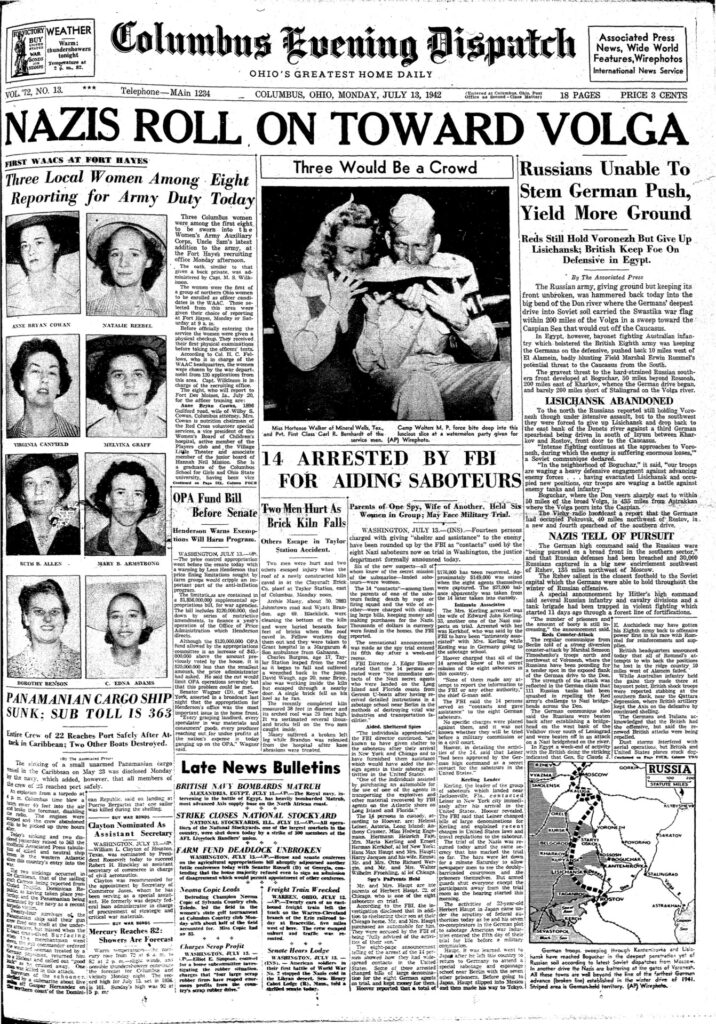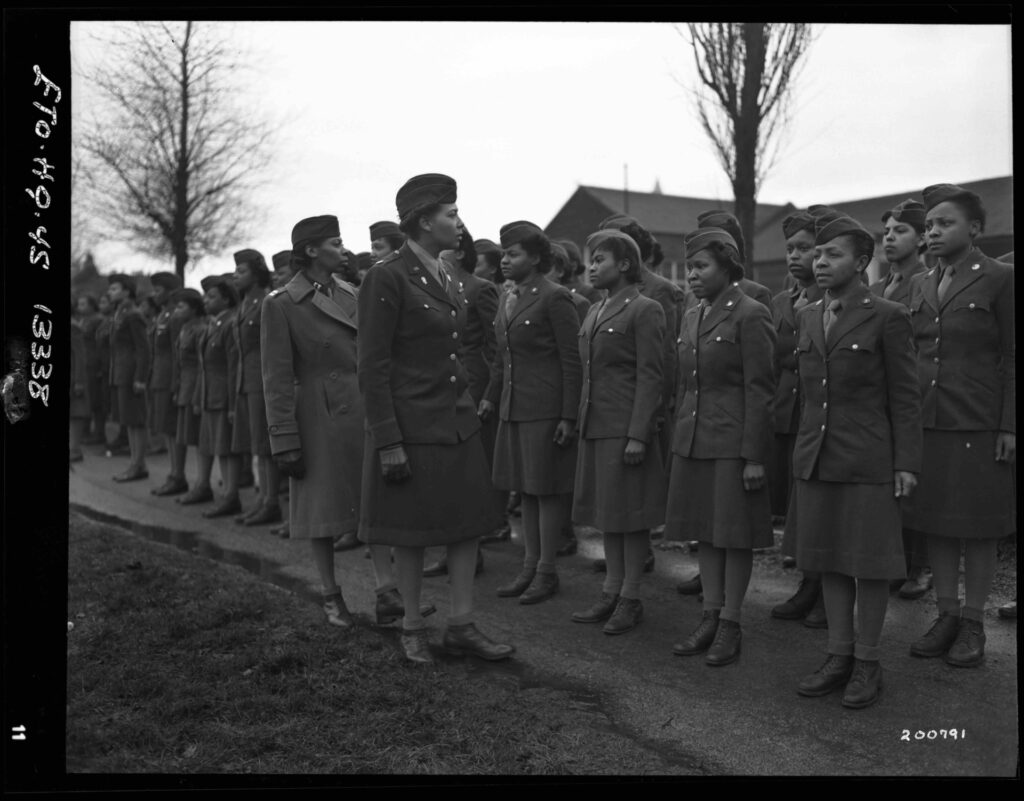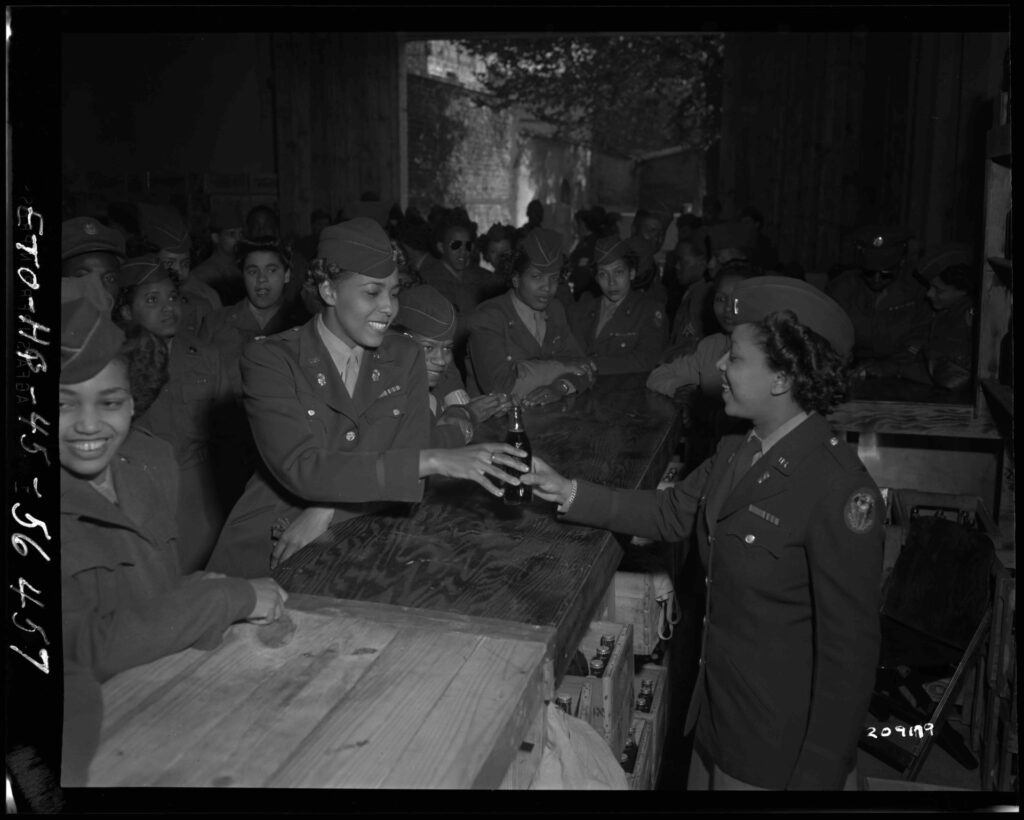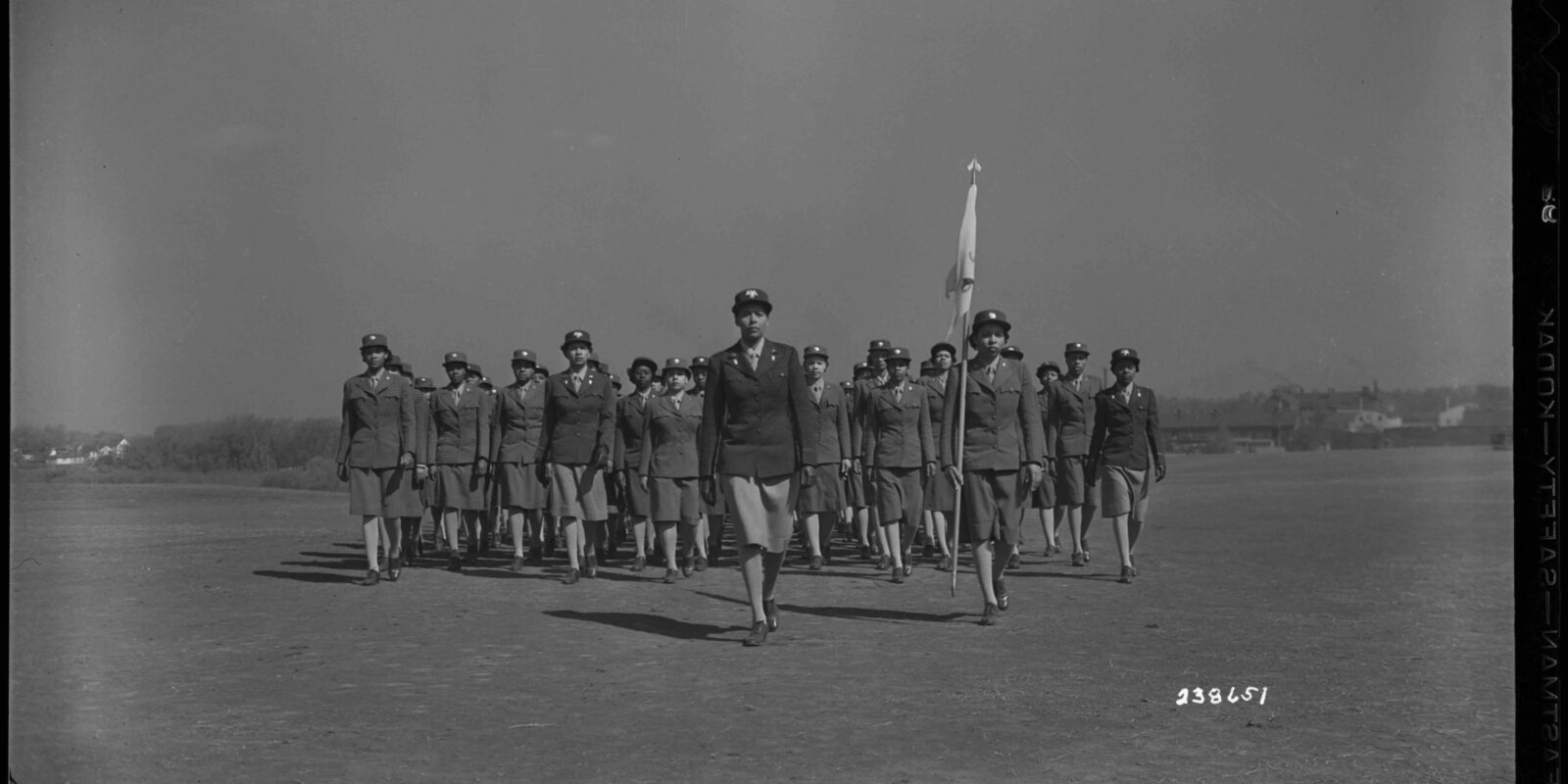Some people are born ready for a challenge. And they seem to convince others along the way that they, too, can achieve the impossible. When Charity Adams — played by actress Kerry Washington in The Six Triple Eight — addresses her battalion in the movie, she said these words with the tenacity befitting a special echelon of Buckeyes:
“They did not send us because they thought we could do it. We are here because they are sure we cannot.”
Football rivalries or Nobel prizes might come to mind. But among the alumni of Ohio State’s College of Education and Human Ecology is another brand of fierce persistence through adversity. Charity Adams Earley, ’47 MA, is among a cadre of Black women alumni who took on racism when it challenged their dreams.
Adams Earley was in the first class of Black commissioned officers in the Women’s Army Auxiliary Corps in 1942. Three years later, as a major only 26 years old, she led the only Black women’s corps to Europe during World War II. Their assignment — to sort warehouses full of undelivered mail in wartime England. Director and screenwriter Tyler Perry drew heavily from Adams Earley’s book, One Woman’s Army: A Black Officer Remembers the WAAC.
What the film doesn’t mention, though, is Adams Earley’s roots at The Ohio State University. Before she became an Army major, or led the first battalion of Black women overseas, and before that unit broke all expectations by sorting and delivering 195,000 pieces of mail a day for months, Adams Earley was a master’s student in the College of Education.
Becoming a Buckeye
Adams Earley had graduated with degrees in mathematics and physics from Wilberforce University, a historically Black university 20 miles east of Dayton. She went home to Columbia, South Carolina, to teach “in the same segregated system where I had been a student.”
“Between school years I attended the summer quarters at Ohio State University,” Adams Earley wrote in her autobiography. “There was not much direction in my academic pursuits during the first two summer quarters. By the third quarter I knew what I wanted to do, and I registered as a candidate for a master’s degree.”
She studied vocational psychology in the College of Education in 1942. But World War II raged in Europe. When her former dean at Wilberforce recommended her for the WAAC, she applied. When she didn’t hear back right away, she hopped on a train bound for Ohio to begin another academic quarter at Ohio State.
“When the Southern Railway’s Carolina Special, enroute to Columbus, stopped in Knoxville, Tennessee, I found my aunt waiting at the station,” she wrote. Adams Earley was easy to find in the segregated train.
“I was to call home immediately,” she wrote.
She telephoned from the Knoxville station, holding up the train and an impatient conductor. She was to report to the Army base in Atlanta the next morning, according to a telegram her family read to her. She kept going to Columbus anyway.

Among first Black WAAC officers
Fort Hayes, now a Columbus City Schools high school, was an Army base north of Ohio State’s campus in 1942. Adams Earley had her records transferred and was interviewed at Fort Hayes for the officer candidate position. A colonel asked if she thought she could lead 10,000 troops overseas.
“I found an answer: ‘If any other woman can, given the same training and opportunity, I can,’” she told the colonel.
She was sworn into the WAAC on July 14, 1942. Her photo appeared with those of seven other officer candidates — all white — in the Columbus Dispatch.
“I, a Negro, had my picture on the front page of a white daily without having done anything criminal,” Adams Earley wrote, “a most unusual situation that added to the community’s support of my actions.”
The main headline on the page: Nazis Roll on Toward Volga. The push was on to defeat Hitler, and women wanted to be a part of the effort. The Dispatch story and others like it kickstarted an intense media fascination with Adams Earley and the Black women’s corps.
Enroute to Fort Des Moines for officer training, she shared a train bunk with a faculty member from Ohio State. Adams Earley was among the first 39 Black women trained to lead the Women’s Army Corps. (The unit was segregated from white officer candidates.) She spent most of the next three years training Black recruits and advancing her rank to major, the first Black woman to do so, in 1943. Then came the ultimate test.
Standing up against oppression
Having grown up in the South, Adams Earley was accustomed to being on the receiving end of racism. “I knew that there was no such thing as separate but equal,” she wrote.
She talked at length about the racial barriers she faced, said her son, Stanley Earley III.
She once attended an NAACP meeting where her father, a minister, spoke. They came home to a house surrounded by the Ku Klux Klan. She sat in panicked silence in the dark with her mother, sister and brother until the crowd dissipated hours later.
Though she wore a captain’s bars, she was not always treated with the respect the rank implied. While traveling by train, a steward once blocked her entry into a dining car where military officers ate. It happened again in Washington, D.C.
“The waiters all put down their trays until they were seated,” said Earley, her son. The stunning aspect of that allyship: “The waiters were largely German prisoners of war,” he said.
Soon after the war, and before she wrote One Woman’s Army, Adams Earley penned a manuscript about her experiences. It was never published.
“Reading it was really a wonderful experience for me, because this woman was going to be my mother, long before I was an idea,” Earley said. “There’s sort of a youth and fire and not as much polish in that writing. But there was also a difference in the times (between the two writings) that was pretty extraordinary, and that is, instead of the focus being on the discrimination, it was more like when it didn’t happen. It was just such a norm that they would be discriminated against, that when somebody didn’t, (that) was the news.”
The racial slurs she received from other Army officers and wait staff only sharpened Adams Earley’s resolve. As a major, when she spoke to training companies, she told them to stand tall against the opposition.
“The eyes of the public would be upon us, waiting for one slip in our conduct or performance,” she wrote. “I talked about the necessity for cooperation and goodwill and, above all, the elimination of prejudice and pettiness toward each other.”
“I felt that there was no better time than this to remind the troops … there had been such a strong opposition not only to such units going overseas but even to their membership in the corps,” Adams Earley recalled.
Many expected their ultimate failure. We are here because they are sure we cannot.
It was time to put their resolve to work.

The 6888th goes to wartime Europe
In 1943, the Women’s Auxiliary Army Corps officially became the Women’s Army Corps, part of the active-duty U.S. Army. The next year, the war reached a fevered pitch in the Battle of the Bulge. Tens of thousands of servicemen died, were wounded or went missing. Those still in combat frequently switched positions along the front.
Back home, families desperately wanted to hear from loved ones. The soldiers’ morale ebbed, too, as they witnessed horrors of war and hoped for news from home to buoy them.
But the news wasn’t coming. Mail for seven million service members got crossed in the tumult of battle. Undeliverable letters and packages — millions of them — ended up warehoused in Birmingham, England (not in Scotland, as the movie depicted).
Unlike her movie character, Adams Earley wasn’t chafing to get an assignment in Europe. But the idea grew on her after her commanding officer suggested it. So, she found herself sleeping on the floor of a transport plane lined with bucket benches, landing in the Azores when a crack appeared in the engine. Her orders were to command a WAC battalion of 855 Black women — the 6888th Central Postal Directory — in Birmingham. They were to fix the military’s mail problem — and they had six months to do it.
“We worked three eight-hour shifts, seven days a week,” she wrote. “When we began work in February 1945, there was a large backlog of mail to be moved. Great quantities of mail.”
Six airplane hangars were filled nearly to the rafters with Christmas packages alone. More contained letters.
“One of our first jobs was to get these packages to the troops,” Adams Earley wrote.
Service members were responsible for updating address cards when they moved. But combat created chaos; those near the front might send several address changes each week — or none at all. So the WACs used GIs’ serial numbers and became experts at matching nicknames to service records.

Packages disintegrated. The restoration unit identified associated smells, color rub-off, damage from moisture and packing materials like newspapers to match contents.
“Some of the women had developed great skill at putting packages back together based on how certain items fitted together in what was left of the original box,” Adams Earley wrote.
The unit broke records for redirecting mail. “Each eight-hour shift averaged over 65,000 pieces of mail …” wrote a WAC lieutenant colonel. “Long-delayed letters and packages reached battle casualties who had been moving too frequently for mail to catch up with them.”
The corps emptied the Birmingham hangars in 90 days — half the time allotted. But the work was not done. The Army moved the unit to Rouen, France, closer to troops. Adams Earley went ahead, arriving by train in Paris on May 8, 1945. She disembarked, completely unaware that Allied victory had just been declared in Europe.
“From the moment we stepped off the train, everyone in U.S. military uniform was subjected to the victory hysteria of the French,” she wrote. “We were kissed on the cheek, sometimes on the lips, offered drinks, asked for souvenirs, and if you had none, something was taken: your cap, insignia, epaulettes, even the braid on the sleeves. All the time this was happening to me, I was just trying to get to the billeting office or the transportation office, or even the military police. When I lost one shoestring as a souvenir, I began to be desperate.”
She arrived disheveled but intact at the office.
Advancing minority rights in the military
The U.S. Army gave Adams Earley a chance to advance her career in ways that civilian life hadn’t. The military remained segregated until 1948 but Black leaders pushed for and found an audience with Eleanor Roosevelt, and at times President Roosevelt, to make the Armed Forces more inclusive. Still, racial bias was part of the military landscape.
A general thought too few 6888 troops showed up for his surprise inspection and threatened to send a “white first lieutenant” to take over Adams Earley’s unit. Then he nearly court martialed her for responding, “Over my dead body, sir.” According to her book, the general later told Adams Earley that her resolve had changed his perspective on Black service members.
“‘It’s been a long time since anyone challenged me, black or white, but you took me on. You outsmarted me and I am proud that I know you,’” the book quotes the general.
Britain’s streets were replete with racial and ethnic diversity, and Brits seemed to embrace the 6888. It was an American group, the Red Cross, that tried to force segregation on the Black corps in its London hostels. So, Adams Earley gave her Black corps the option to sleep elsewhere, and they did.
The boycott worked. “They basically gave up on trying to have separate hotels for the Black women,” said Earley, her son.
“What we had was a large group of adult Negro women who had been victimized, in one way or another, by racial bias,” she said. “This was one opportunity to stand together for a common cause.”
“Since the day I had been sworn into the WAAC, every moment had been a challenge,” she wrote. “The problems of racial harmony, black acceptance, and opportunity were still unresolved, but these problems I could still work to help solve as a civilian. Besides, I was beginning to feel the racial situation was worse in civilian life.”
In December 1945, Adams Earley was promoted to lieutenant colonel. But it was time to go home. She chose to return to Ohio State to finish her master’s degree.
A student again, but with her doubts
After being awarded medals for distinguished service and interviewed by the press, including the Ohio State Lantern, Adams Earley tried to settle in as a master’s student. She was now 27. But she was apprehensive about being a student.
“All of my self-confidence was suddenly dissipated …” she wrote. “I took copious notes from the lectures but did not dare participate in class discussions.”
A woman who had achieved the highest rank available to her in the Army was experiencing imposter syndrome in her classes.
Her philosophy of education professor noticed. He was likely H. Gordon Hullfish, known for his work exploring democratic principles in education. He, of all professors, would have wanted Adams Earley to speak up about her beliefs surrounding education.
‘Miss Adams,’ he said, ‘I remember you as a very active participant in other classes you had with me. You have not said a word this quarter.’
‘Well, Sir, … I have been away from the world of education for almost four years and I am sure that things have changed so much that any comments I have would not be relative.’
‘Nothing has changed. While you were away fighting to save democracy, we kept education just as it was.’
Adams Earley received her degree just three academic quarters after returning. She went to work for the Cleveland Veterans Administration and married Stanley Earley Jr. (’41 BA Biological Sciences), whom she met before the war. They moved to Zurich, where he attended medical school because most United States universities didn’t admit Black medical students. Once home, Adams Earley served as dean of student personnel at two colleges and eventually settled in Ohio. “She was very involved in desegregating schools in Dayton,” Stanley Earley III said.
Despite the discrimination her troops faced at the hands of the American Red Cross, Adams Earley served on the organization’s national board of directors for years. “She was not a grudge holder,” her son said.
She died at age 83 in 2002.
A memorial dedicated to the 6888th at Fort Leavenworth, Kansas, includes a bronze bust of Adams Earley. At a dedication ceremony in 2018, several surviving members of the battalion showed up, encircling their leader’s likeness with their wheelchairs.
A description below the bust calls them and Adams Earley “weaponless women warriors.”
If any other woman can, given the same training and opportunity, I can.
And so, they all did … together.

